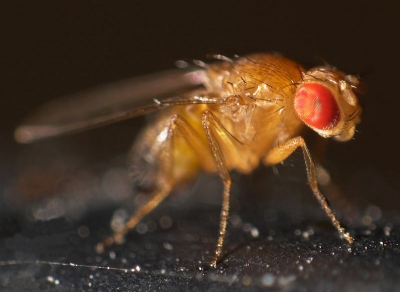 Like humans, fruit flies are diurnal animals. They wake at dawn, eat what they can find, and sleep at dusk. This twenty-four-hour routine, called a circadian rhythm, is controlled by the sun’s light-dark cycle. The clock is set so a fly, or human, is primed to be active during the day and inactive at night.
Like humans, fruit flies are diurnal animals. They wake at dawn, eat what they can find, and sleep at dusk. This twenty-four-hour routine, called a circadian rhythm, is controlled by the sun’s light-dark cycle. The clock is set so a fly, or human, is primed to be active during the day and inactive at night.
Circadian rhythms may also be involved in stem cell replication, according to a surprising discovery by Phillip Karpowicz, PhD, a Harvard Medical School research fellow in genetics. While studying stem cell replication in fruit fly intestines, he found the circadian rhythm gene period to be a necessary factor in regulating this activity. “I was shocked when the circadian clock genes were hits in my screen,” he said. “I didn’t think that regeneration would follow any particular timing.”
Experiments showed flies that express the period gene have a predictable, synchronous replication of their intestinal stem cells that follows a twenty-four-hour cycle. The timing of the cell division matches with the timing of when flies eat their meals. Flies that had their period gene expression blocked experienced an asynchronous or poor intestinal stem cell division.
Karpowicz believes that his finding has implications for identifying the best times for cancer therapies to be administered in humans “I think certain interventions, like chemotherapy and radiation therapy that can kill dividing cells in the intestinal lining need to take timing into account,” he said.
Karpowicz will next be looking in mice to see if circadian rhythm genes are involved in mammalian intestinal regeneration. Karpowicz works in the lab of Harvard Stem Cell Institute Affiliated Faculty member Norbert Perrimon, PhD, the James Stillman Professor of Developmental Biology in the Harvard Medical School Department of Genetics.
Source: The Circadian Clock Gates the Intestinal Stem Cell Regenerative State. Cell Reports. April 25, 2013.
Photo: Fruit fly. (Credit: Mr.checker/wikimedia commons)
